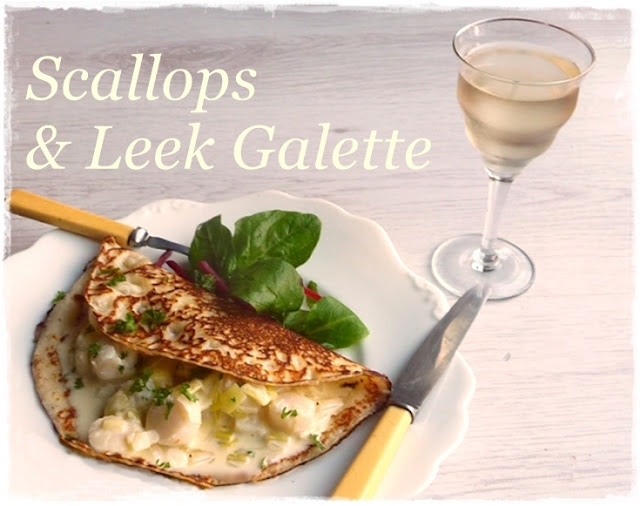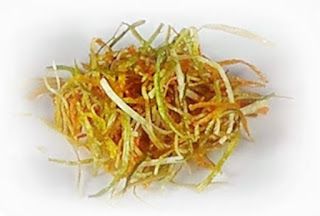It’s British Leek Season – Hurrah!
Did you know that today marks the start of the British leek season which runs all the way through to April?
Jolly good too because leeks are seriously
one my favourite vegetables and not just in an accompaniment kind of a way. For me leeks are a delicious and important main
flavour in numerous dishes. I almost always have a leek about the place and I recommend
you do the same!
To mark this auspicious occasion I have
been asked to write a little about these delicious alliums together with one of
my favourite recipes so do please read on.
Firstly and importantly leeks do tend to
have a little grit and dirt between their leaves so here is a good way of
washing them …
How to Prepare & Wash Leeks
The easiest way, I find, is to top and tail the leek, run a knife along its edge and remove and discard the out edge. Split the leek in half lengthwise and then slice crosswise. Put into a large bowl with PLENTY of cold water so that the sliced leek floats. Swirl about a bit, let the water calm down and then carefully lift the leeks out so that the soil and grit, which has sunk to the bottom, stays in the bottom where it belongs. Do not strain them.
Secondly here is a great way of cooking
leeks which makes them sweet and tender and concentrates their flavour.
A Great Way to Cook Leeks
~ Heat a knob of butter (or olive oil or bacon fat) in a saucepan with a lid and toss and separate the washed and drained leeks in the fat to coat.
~ Sprinkle
with a little salt.
~ Press something appropriate (a piece of foil, a piece of baking parchment, greaseproof paper or a butter wrapper) directly onto the leeks to cover completely. Try not to burn yourself on the side of the pan.
>~ Turn
the heat down to low and put the lid on the pot; the leeks should not so much
fry in the butter as gently steam in it.~ Press something appropriate (a piece of foil, a piece of baking parchment, greaseproof paper or a butter wrapper) directly onto the leeks to cover completely. Try not to burn yourself on the side of the pan.
~ Cook slowly until they are very tender – you can stir once or twice during this time and they should take about 20 minutes.
Leeks cooked this way are really useful being great in everything from soups (see here for my Leek & Potato Soup recipe plus a bit of a rant!) to lovely mashed potato, posh cheese on toast, Alfredo Sauce (for pasta and lots of other things), stirred through cooked peas and even in baked things such as scones or on pizza. They are, however particularly good with seafood. I often have them with salmon but a very delicious dish I ate in France a few years ago and then replicated at home is …
Breton Scallop & Leek Galettes
"Galettes" (Galettes de Sarrasin to use
their full name) in Brittany refers to a particularly delicious (and, as a
bonus, gluten free) type of crèpe made of buckwheat. They are light and crisp
with a slightly nutty flavour. The galette recipe is below but if you haven’t
got any buckwheat normal crèpes will stand in pretty well.
The main subject of this post is the
scallop and leek filling – aha, we get to it at last!
Scallops in a Creamy Leek Sauce
Use either the little queen scallops or the
larger ones, in which case slice them before cooking.
2
small leeks – cleaned and thinly sliced
30g butter
50ml dry white wine
150ml double cream
300g raw scallops
salt and pepper
30g butter
50ml dry white wine
150ml double cream
300g raw scallops
salt and pepper
~
Prepare and cook the leeks in the butter as above.
~ Add the wine or stock and allow to simmer for a minute or two.
~ Stir in the cream, bring to a boil then turn down the heat and simmer a few minutes. Taste and season.
~ At this stage you could set the sauce aside to later.
~ To cook the scallops just reheat the sauce to boiling, turn down to a low simmer, add the scallops and leave on the heat just till the first bubble appears on the surface of the sauce. Set aside, covered, to finish cooking in the residual heat of the sauce. Scallops are very delicate chaps and any more cooking could toughen them.
~ Add the wine or stock and allow to simmer for a minute or two.
~ Stir in the cream, bring to a boil then turn down the heat and simmer a few minutes. Taste and season.
~ At this stage you could set the sauce aside to later.
~ To cook the scallops just reheat the sauce to boiling, turn down to a low simmer, add the scallops and leave on the heat just till the first bubble appears on the surface of the sauce. Set aside, covered, to finish cooking in the residual heat of the sauce. Scallops are very delicate chaps and any more cooking could toughen them.
Oh – I’ve just thought of another good leek
idea; this is a fancy garnish I used to do a lot when cheffing …
Cut a leek into long thin strips, rub a
little cornflour through them (this makes them crunchy) and deep fry for a few
minutes till they are golden. Lift out of the oil with a skimmer and drain on
kitchen roll. Sprinkle with a little crunchy sea salt.
Buckwheat Pancakes
This makes 4 large pancakes or more smaller ones, obviously!
100g
buckwheat flour
pinch of salt
1 egg
300ml milk
50g butter – melted
pinch of salt
1 egg
300ml milk
50g butter – melted
~
Stir together the salt and the flour and make a well in the middle.
~ Break the egg into the well and start whisking it in gradually adding the milk till a batter the consistency of single cream is achieved.
~ Chill for a couple of hours then stir in the melted butter.
~ Proceed to make pancakes as per usual, ie. lightly grease a frying pan, bring to good heat and ladle in about 2 tablespoons of batter.
~ Roll the pan to spread the batter thinly and cook till the underside is golden.
~ Turn with a deft flip of the wrist or more carefully with an implement.
~ Break the egg into the well and start whisking it in gradually adding the milk till a batter the consistency of single cream is achieved.
~ Chill for a couple of hours then stir in the melted butter.
~ Proceed to make pancakes as per usual, ie. lightly grease a frying pan, bring to good heat and ladle in about 2 tablespoons of batter.
~ Roll the pan to spread the batter thinly and cook till the underside is golden.
~ Turn with a deft flip of the wrist or more carefully with an implement.
So that's it from me but for lots more recipes, tips and info on
British leeks go here.






2 comments:
Or, cooked as above and slathered all over freshly made toast......yum! It may not be the healthiest of lunches, but it's very tasty!
I utterly agree with you Legaleagle!
Post a Comment